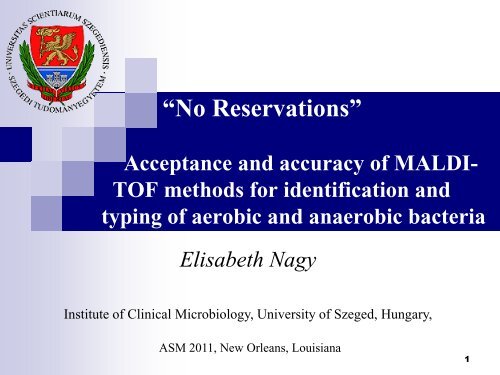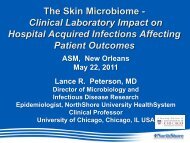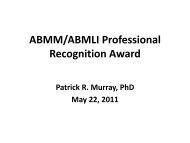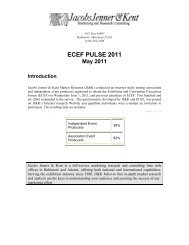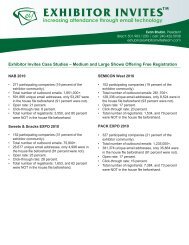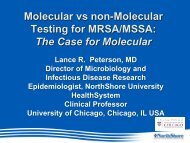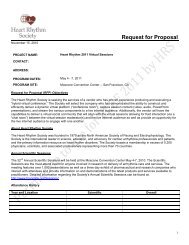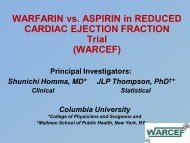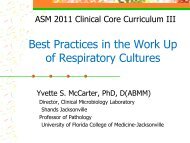B. fragilis
B. fragilis
B. fragilis
You also want an ePaper? Increase the reach of your titles
YUMPU automatically turns print PDFs into web optimized ePapers that Google loves.
“No Reservations”<br />
Acceptance and accuracy of MALDI-<br />
TOF methods for identification and<br />
typing of aerobic and anaerobic bacteria<br />
Elisabeth Nagy<br />
Institute of Clinical Microbiology, University of Szeged, Hungary,<br />
ASM 2011, New Orleans, Louisiana<br />
1
Gram-negative aerobic bacterium isolated from blood culture<br />
gentamicin<br />
amikacin<br />
tobramycin<br />
netilmicin<br />
If it is an Escherichia coli all aminoglycosids can be used !!!<br />
If it is a Salmonella sp., despite of the susceptibility to<br />
aminoglycosides in vitro , they are ineffective in vivo !!!!<br />
2
Only 12 of 23 Bacteroides<br />
species are in the database<br />
3
Possibilities for species determination in<br />
routine laboratories<br />
Classical methods using phenotypic characteristics<br />
Automation of biochemical tests<br />
Use of short-chain fatty acid production (anaerobic<br />
bacteria)<br />
DNA-based identification<br />
(DNA-DNA hybridization)<br />
16S rRNA gene sequencing (whole DNA sequencing )<br />
Protein-based identification (based on small ribosomal<br />
proteins) by mass spectrometry<br />
4
History<br />
1975: the first use of MS for bacterial identification<br />
(Anhalt et al. Anal Chem 1975)<br />
Limited mass range (
Protein-based, “real-time” species<br />
identification MALDI-TOF MS<br />
Microflex LT TM<br />
Bruker Daltonics<br />
MALDI BioTyper:<br />
software,<br />
bioinformatics,<br />
database<br />
Species identification within 10<br />
minutes if it is included in the<br />
database<br />
Launchpad software<br />
SARAMIS database<br />
AXIMA<br />
Shimadzu<br />
6
m/z<br />
Technical description of<br />
MALDI-TOF MS<br />
Emonet et al. CMI 16: 1604-13, 2010<br />
7
An anaerobic clincal isolate<br />
Identification view: sample MSP stick<br />
spectrum (upside) and reference MSP<br />
stick spectrum (downside)<br />
Gel overview: view<br />
of sample MSP<br />
MALDI-TOF Biotyper<br />
Taxonomy tree<br />
view: Based on<br />
NCBI taxonomy<br />
browser<br />
MSP results and<br />
log(score) values<br />
8
Sample preparation<br />
Direct transfer of a colony of bacteria or yeasts onto the target<br />
or<br />
Pretreatment:<br />
One colony is suspended in 300 μl bidistilled water<br />
900 μl ethanol is added and mixed thoroughly<br />
Centrifugation for 2 min – the pellet is dried<br />
Re-suspend in up to 50 μl 70% aqueous formic acid and 50 μl<br />
acetonitrile<br />
Centrifugation for 2 min and 1 μl supernatant is spotted on the target<br />
plate and dried at room temperature<br />
(in the case of some pathogens special sample preparation is needed)<br />
Pretreated and untreated samples are overlaid with 1 μl matrix<br />
solution<br />
Measurements are usually made on multiple parallels<br />
9
Identification of clinically relevant pathogens (1)<br />
Enterobacteriaceae (Conway, et al. J Mol Microbiol Biotechnol 2001)<br />
Genetically distinct E. coli strains could be identified and distinguished<br />
from several other genera/species of Enterobacteriaceae<br />
Non-fermenters (Mellmann et al. J Clin Microbiol 2008 and 2009)<br />
- 248 culture collection strains<br />
belonging in 37 genera were used to<br />
set up the database<br />
- MALDI-TOF identified 67 of 78<br />
(85.9%) clinically relevant<br />
non-fermenters concordant with the<br />
sequencing<br />
- Mean log(score) values for 60<br />
blind-coded samples identified by 8<br />
laboratory were evaluated<br />
97.3% of all log(score) values were >2<br />
10
Identification of clinically relevant pathogens (2)<br />
Staphylococci (Carbonnelle et al. J Clin Microbiol 2007; Szabados et<br />
al. J Med Microbiol 2010)<br />
Enterococci (Eigner et al. Clin Lab 2009)<br />
Streptococci (Friedrichs et al. J Clin Microbiol 2007)<br />
Neisseria spp (Ilina et al. J Mol Diagn 2009)<br />
Listeria monocytogenes (Barbuddhe et al. Appl Environ Microbiol<br />
2008)<br />
Mycobacteria (Pignone et al. J Clin Microbiol 2006)<br />
Etc.<br />
11
1. retrospective study<br />
2. prospective study<br />
J Clin Microbiol 48: 900-907 (2010)<br />
12
~5000 clinical isolates; 2009-2010<br />
Conclusions: > 90% of all clinical isolates,<br />
94% of Gram-negative bacteria and<br />
89.8% of Gram-positive bacteria were identified at a species level<br />
13
Use of MALDI-TOF MS for typing of bacteria<br />
Appl Enviroment Microbiol 74:5402 (2008)<br />
Besides the rapid identification of 146 different Listeria<br />
strains, 16 L. monocytogenes were typed and the PFGE<br />
profile gave a result identical with that of MALDI-TOF MS<br />
14<br />
II.<br />
I.<br />
III.
- By analysis of MS of 25 MRSA isolates belonging in<br />
the 5 major HA-MRSA clonal complexes, 13 m/z<br />
values were found which discriminated them.<br />
- 60 further clinical isolates were tested. 15 different<br />
MALDI types could be differentiated.<br />
Int J Med Microbiol 301:64-68 (2011)<br />
15
Use of MALDI-TOF MS for identification of<br />
anaerobic bacteria<br />
Difficult to isolate from mixed infections in pure<br />
culture<br />
Most of them are slow-growing (small colonies)<br />
Classical methods are time-consuming<br />
Automated phenotypic methods need a large<br />
inoculum (difficult to achieve)<br />
Many clinically important anaerobes are inactive<br />
16
Shah et al. CID 35: S58-64 (2002)<br />
Through the use of intact cell MALDI-TOF MS, Porphyromonas<br />
strains could be differentiated<br />
Porphyromonas<br />
culture collection<br />
strains<br />
Prevotella intermedia belonged in 3 different subgroups and P.<br />
nigrescens was more homogeneous by MS<br />
17
Intens. [a.u.]<br />
Intens. [a.u.]<br />
Intens. [a.u.]<br />
Intens. [a.u.]<br />
Intens. [a.u.]<br />
Identification of Bacteroides strains by MALDI Biotyper<br />
4<br />
x10<br />
3<br />
2<br />
1<br />
0<br />
4000<br />
2000<br />
0<br />
4000<br />
3000<br />
2000<br />
1000<br />
0<br />
x104<br />
1.00<br />
0.75<br />
0.50<br />
0.25<br />
0.00<br />
x104<br />
1.5<br />
1.0<br />
0.5<br />
0.0<br />
Bacteroides <strong>fragilis</strong> ATCC 25285\0_M11\1\1SLin<br />
Bacteroides massiliensis DSM 17679_DSM\0_A12\1\1SLin Raw<br />
Bacteroides eggerthii DSM 20697_DSM\0_K11\1\1SLin Raw<br />
Bacteroides nordii DSM 18764_DSM\0_I3\1\1SLin Raw<br />
Bacteroides intestinalis DSM 17393_DSM\0_A22\1\1SLin Raw<br />
3000 4000 5000 6000 7000 8000<br />
m/z<br />
18<br />
Nagy et al: CMI 15: 796-802 (2009)
Species determination of 277 Bacteroides isolates with commercial<br />
identification kits and by MALDI Biotyper<br />
Species Number of isolates<br />
with an identification score with discrepant species selected for 16S rDNA<br />
>2.0 by MALDI-TOF MS identification by biochemical tests sequencing*<br />
Bacteroides <strong>fragilis</strong> 179 5 2<br />
Bacteroides thetaiotaomicron 43 5 4<br />
Bacteroides ovatus 15 6 1<br />
Bacteroides vulgatus<br />
Bacteroides uniformis<br />
20<br />
5 97.5%<br />
1<br />
3 8.3%<br />
1<br />
2<br />
Bacteroides eggerthii 1 0<br />
Bacteroides nordii 4 3 1<br />
Bacteroides salyersiae 1 0<br />
Bacteroides massiliensis 2 0<br />
Inconclusive identification by<br />
MALDI-TOF MS 7 7<br />
*Only strains with a log(score) 2.0-2.5 were selected for sequencing<br />
Nagy et al. CMI 15: 796-802 2009<br />
19
Comparative species determination of selected Bacteroides strains<br />
Sample number Species determined by<br />
_______________________________________________________________________________________________<br />
Biochemical tests MALDI-TOF MS 16S rDNA sequencing<br />
1 B. ovatus B. <strong>fragilis</strong> B. <strong>fragilis</strong><br />
2 B. uniformis B. <strong>fragilis</strong> B. <strong>fragilis</strong><br />
3 B. ovatus B. thetaiotaomicron B. thetaiotaomicron<br />
4 B. uniformis B. thetaiotaomicron B. thetaiotaomicron<br />
5 B. uniformis B. thetaiotaomicron B. thetaiotaomicron<br />
6 B. ovatus B. thetaiotaomicron B. thetaiotaomicro<br />
7 B. uniformis B. ovatus B. ovatus<br />
8 B. thetaiotaomicron B. vulgatus (log(score) 2.023) Bacteroides sp (new?)<br />
9 B. ovatus B. uniformis B. uniformis<br />
10 B. ovatus B. uniformis B. uniformis<br />
11 B. ovatus B. nordii B. nordii<br />
_______________________________________________________________________________________________<br />
12 B. thetaiotaomicron II*(log(score)>2.5) P. (B.) distasonis<br />
13 P. (B.) distasonis II P. (B.) distasonis<br />
14 P. (B.) distasonis II(log(score)>2.5) P. (B.) distasonis<br />
15 P. (B.) distasonis II(log(score)>2.5) P. (B.) distasonis<br />
16 B. thetaiotaomicron II B. eggerthii<br />
17 B. merdae II B. goldsteinii<br />
18 Bacteroides sp II B. intestinalis<br />
*II = Inconclusive identification Nagy et al. CMI 15: 796-802 2009<br />
20
Routine identification of anaerobic bacteria by MALDI-TOF<br />
Stingu et al: Oral Microbiology Immunology 2008<br />
84 oral biofilm isolates (including 9 reference strains) were tested<br />
MALDI-TOF was superior to biochemical identification<br />
P. intermedia/nigrescens (37 strains) could be distinguished by MALDI-TOF MS<br />
Veloo et al: CMI 2010<br />
79 clinical isolates representing 19 genera<br />
Comparison of Bruker and Simadzu system with 16S rRNA gene sequencing<br />
Correct identification at a genus level 61% versus 71% and at a species level 51%<br />
versus 61%<br />
When species not present in the database were excluded 75% versus 76.7%<br />
21
Routine identification of anaerobic bacteria by MALDI-TOF<br />
196 anaerobic bacteria isolated from clinically relevant<br />
samples (blood cultures, abdominal, pelvic, oral, soft tissue infections) during<br />
2009 and 2010 were blindly tested<br />
MALDI-TOF MS identified 166 (84.6%) at a species level with a<br />
log(score) >2.000<br />
184 (93.8%) at a genus level<br />
After 16S rRNA gene sequencing, it turned out that the species was not<br />
included in the database for 10 isolates<br />
In cases of discrepant phenotypic identification (ATB, API and<br />
conventional methods), 16S rRNA gene sequencing supported the<br />
MALDI-TOF identification in 97% of the cases.<br />
Soki J, Nagy E, Backer S : Publication in preparation<br />
22
Dendogram of Bacteroides/Parabacteroides strains according to MALDI-TOF<br />
1000<br />
900<br />
800<br />
700<br />
MSP Dendrogram<br />
600 500<br />
Distance Level<br />
400<br />
300<br />
200<br />
100<br />
x_Bac_HU29105 B. ovatus PNU 99.5% B. thetaiotaomicron<br />
x_Bac_HU29104_4 B. ovatus 99.7% PNU B. eggerthii<br />
x_Bac_HU40347_2 B. vulgatus PNU B. vulgatus<br />
x_Bac_HU33866_2_18 B. thetaiotaomicron PNU B thetaiotaomicron<br />
x_Bac_HU26686_6 B. thetaiotaomicron PNU B. thetaiotaomicron<br />
x_Bac_HU36220 P. distasonis PNU P. distasonis<br />
x_Bac_HU33120_3_13<br />
B. uniformis<br />
PNU<br />
B. unifomis<br />
x_Bac_HU32405_3 PNU B. <strong>fragilis</strong><br />
x_Bac_HU26868_1 PNU B. <strong>fragilis</strong><br />
x_Bac_HU35328_4 PNU B. <strong>fragilis</strong><br />
x_Bac_HU35225 PNU B. <strong>fragilis</strong><br />
x_Bac_HU27912 PNU B. <strong>fragilis</strong><br />
x_Bac_HU28715 B. <strong>fragilis</strong> PNU Bacteroides sp.<br />
x_Bac_HU36562_1 PNU B. <strong>fragilis</strong><br />
x_Bac_HU33866_2_19 PNU<br />
B. <strong>fragilis</strong><br />
x_Bac_HU34886_3<br />
99.5%<br />
PNU<br />
B. capillosus<br />
x_Bac_HU26938_2 PNU<br />
99.5% B. thetaiotaomicron<br />
x_Bac_HU32759 PNU<br />
x_Bac_HU33488 PNU<br />
x_Bac_HU36111_2 PNU<br />
x_Bac_HU26938_1 PNU<br />
B. <strong>fragilis</strong><br />
B. <strong>fragilis</strong><br />
B. <strong>fragilis</strong><br />
B. <strong>fragilis</strong><br />
0<br />
MALDI-TOF 16S rDNA<br />
Phenotypic identification<br />
x_Bac_HU35300_2 PNU<br />
x_Bac_HU37251_1 PNU<br />
x_Bac_HU33120_3_12 PNU<br />
B. <strong>fragilis</strong><br />
B. <strong>fragilis</strong><br />
B. <strong>fragilis</strong><br />
16S rRNA gene sequencing confirmed the identification based on MS<br />
23
Comparative identification of 17 Gram-positive<br />
anaerobic clinical isolates<br />
Biochemical identification Analyte Organism Score<br />
MALDI Biotyper<br />
Name (best match) Value<br />
Finegoldia magna x HU 29644_1 PNU not reliable identification 1.238<br />
Clostridium perfringens x HU66505 PNU Clostridium perfringens 2.473<br />
Clostridium perfringens x HU65634 PNU Clostridium perfringens 2.457<br />
Clostridium perfringens x HU65618 PNU Clostridium perfringens 2.412<br />
Clostridium perfringens x HU64840 PNU Clostridium perfringens 2.439<br />
Clostridium perfringens x HU64432 PNU Clostridium perfringens 2.45<br />
Clostridium difficile x HU59744 PNU Clostridium difficile 2.552<br />
Clostridium sp x HU56448 PNU Clostridium innocuum 2.3<br />
Clostridium perfringens x HU55650 PNU Clostridium perfringens 2.444<br />
Clostridium perfringens x HU53309 PNU Clostridium perfringens 2.434<br />
Clostridium perfringens x HU52508 PNU Clostridium perfringens 2.414<br />
Clostridium clostridioforme x HU52042 PNU not reliable identification 1.406<br />
Clostridium perfringens x HU51221 PNU Clostridium perfringens 2.398<br />
Clostridium tertium x HU46926 PNU Clostridium tertium 2.351<br />
Clostridium innocuum x HU46588 PNU Clostridium innocuum 2.481<br />
Clostridium perfringens x HU39493 PNU Clostridium perfringens 2.475<br />
Clostridium fallax x HU33416 PNU not reliable identification 1.313<br />
16S rRNA<br />
F. magna<br />
C. innocuum<br />
C. hathewayi<br />
B. ureolyticus<br />
24
Use of MALDI-TOF MS to distinguish cfiApositive<br />
and cfiA-negative B. <strong>fragilis</strong> strains<br />
(typing of B. <strong>fragilis</strong>)<br />
Carbapenem resistance in B. <strong>fragilis</strong> is due in most cases to the<br />
presence of the cfiA gene and its expression (IS elements are<br />
needed in the promoter region)<br />
This metallo-beta-lactamase confers resistance to all betalactam<br />
antibiotics<br />
Only B. <strong>fragilis</strong> strains belonging in Division II harbor the cfiA<br />
gene<br />
Different studies indicate an increased resistance of B. <strong>fragilis</strong><br />
to carbapenems and an increased frequency of silent harboring<br />
of the gene<br />
25
Selection of well-characterized B. <strong>fragilis</strong> strains<br />
Strains PCR detection of<br />
cfiA<br />
IS element(s) Imipenem MIC<br />
(mg/L)<br />
1 B. <strong>fragilis</strong> TAL 3636 + IS942 >32<br />
2 B. <strong>fragilis</strong> CZE60 + - 16<br />
3 B. <strong>fragilis</strong> 1672 + IS1186, (IS4351) >32<br />
4 B. <strong>fragilis</strong> BF8 + (IS1186, IS4351) 1<br />
5 B. <strong>fragilis</strong> R19811 + IS614B 32<br />
6 B. <strong>fragilis</strong> O21 + IS1186, (IS4351) >32<br />
7 B. <strong>fragilis</strong> 15470 - nt
Gel/stack view of MSP: zoom 4000 to 6000 Da<br />
02 - CZE60<br />
05 - R19811<br />
01 - TAL3636<br />
03 – 1672<br />
06 – O21<br />
04 – BF8<br />
07 15470<br />
08 – 15476<br />
09 – 15361<br />
10 – 72232_1<br />
11 – 638R<br />
12 9343<br />
cfiA+<br />
cfiA-<br />
Nagy E, et al.: presented during the Congress of ASA, Philadelphia (2010)
02 - CZE60<br />
05 - R19811<br />
01 - TAL3636<br />
03 – 1672<br />
06 – O21<br />
04 – BF8<br />
______________<br />
07 15470<br />
08 – 15476<br />
09 – 15361<br />
10 – 72232_1<br />
11 – 638R<br />
12- 9343<br />
Gel/stack view of MSP (zoom 4600 to 4850 Da)<br />
cfiA +<br />
cfiA -<br />
Intens. [a.u.]<br />
4<br />
x10<br />
1.0<br />
0.8<br />
0.6<br />
0.4<br />
0.2<br />
0.0<br />
4688<br />
4711<br />
4817<br />
4826<br />
4650 4700 4750 4800 4850
B. <strong>fragilis</strong> strains tested blindly for cfiA positivity by MALDI-TOF<br />
Gel/stack view: zoom 4000–5200 Da<br />
06 PNU<br />
11 PNU<br />
12 PNU<br />
13 PNU<br />
14 PNU<br />
15 PNU<br />
16 PNU<br />
18 PNU<br />
19 PNU<br />
01 PNU<br />
02 PNU<br />
04 PNU<br />
05 PNU<br />
07 PNU<br />
08 PNU<br />
09 PNU<br />
10 PNU<br />
17 PNU<br />
20 PNU<br />
21 PNU<br />
22 PNU<br />
23 PNU<br />
24 PNU<br />
26 PNU<br />
27 PNU<br />
28 PNU<br />
31 PNU<br />
33 PNU<br />
34 PNU<br />
Putative<br />
cfiA+<br />
Putative<br />
cfiA-<br />
29
Retrospective analysis of mass spectra of 145<br />
B. <strong>fragilis</strong> isolates<br />
9 of 145 B. <strong>fragilis</strong> strains had characteristic peaks for Division II (cfiA-positive)<br />
Strains Characteristic peaks CfiA (PCR) Imipenem MIC (mg/L)<br />
B. <strong>fragilis</strong> A20 4826, 9375, 9649 +
Dendogram of B. <strong>fragilis</strong> isolates according to MALDI-<br />
TOF MS measurements<br />
41 cfiA-positive isolates<br />
Division II<br />
207 cfiA-negative isolates<br />
Division I<br />
Wybo et al. JCM (2011)<br />
31
Identification and typing of bacteria in<br />
the future by MALDI-TOF MS?<br />
The method is easy to use<br />
Very rapid and the running costs are low<br />
The equipment is suitable for multiple usage<br />
However,<br />
Extensive development of the databases is needed<br />
Standardization should be carried out to obtain<br />
comparable results<br />
32
The studies carried out on the identification and typing of<br />
anaerobic bacteria in our laboratory were supported by research<br />
grants from:<br />
Hungarian National Research Foundation (OTKA-K-69044)<br />
Hungarian Office of Science and Technology (GVOP-0304)<br />
ESCMID grant for the Study Group for Anaerobic Infections (ESGAI)<br />
and were performed in cooperation with Bruker Daltonik<br />
GmbH, Bremen, Germany<br />
Szeged, Hungary: Edith Urbán, József Sóki, Noémi Bartha<br />
Bremen, Germany: Simone Backer, Tomas Maier, Markus Kostrzewa<br />
33
Sincere apologies to authors whose<br />
work could not be cited here.<br />
34


